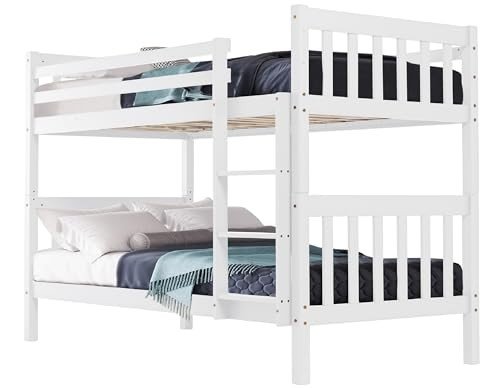Exploring Bunk Beds: A Comprehensive Guide
Bunk beds have long been a staple in children's bed rooms, dorms, and even homes with limited space. Not only do they provide a useful sleeping option, but they likewise develop a fun and creative environment for children and a great space-saver for adults and families. This short article will explore whatever you require to understand about bunk beds, from types and materials to safety ideas and purchasing suggestions.
Tabulation
- Kinds Of Bunk Beds
- Traditional Bunk Beds
- Loft Beds
- Triple Bunk Beds
- L-Shaped Bunk Beds
- Material Options
- Wood
- Metal
- Safety Considerations
- Purchasing Guide
- FAQs
Kinds Of Bunk Beds
Bunk beds are available in various styles to suit different needs and preferences. Here's a breakdown of the most common types:
Conventional Bunk Beds
Traditional bunks usually feature 2 beds stacked vertically on top of one another. These beds are ideal for brother or sisters sharing a space or for making the most of sleeping space in visitor spaces.
Loft Beds
Loft beds stand likewise to standard bunk beds however do not have a lower sleeping area. Rather, they typically integrate a desk or seating area below, making them a great option for little spaces needing multifunctionality.
Triple Bunk Beds
Triple bunk beds are designed for 3 occupants, with beds stacked in a three-tier setup. These are less common however can be an enjoyable option for large families or sleepovers.
L-Shaped Bunk Beds
With one bed placed horizontally and the other vertically, L-shaped bunk beds are often geared up with extra functions such as desks or storage drawers and can match corner areas in a space.
Comparison of Bunk Bed Types
| Bed Type | Ideal Use | Description |
|---|---|---|
| Standard | Shared bedrooms or guest spaces | 2 beds stacked vertically |
| Loft | Little spaces needing multi-purpose space | Upper bed with open space beneath |
| Triple | Large families or pajama parties | Three beds stacked vertically |
| L-Shaped | Corner or flexible areas | A mix of vertical and horizontal beds |
Product Options
Bunk beds are made from numerous materials, with wood and metal being the most common. Each material has its advantages and disadvantages.
Wood
- Toughness: Generally robust and can hold up against years of use.
- Visual Appeal: Offers a classic appearance that can blend with different designs.
- Weight Capacity: Typically tougher; can support much heavier weights.
- Drawbacks: May be more expensive than metal choices and can be susceptible to scratches.
Metal
- Toughness: Generally light-weight and easy to move however still tough.
- Modern Design: Often is available in smooth designs, making it appealing for contemporary areas.
- Cost-Effective: Usually less costly than wooden choices.
- Drawbacks: Can be cold to the touch in winters and might not have the very same visual appeal for some buyers.
Safety Considerations
When it comes to bunk beds, safety can not be overlooked. Here are key security tips to keep in mind:
- Guardrails: Ensure that the leading bunk has guardrails on both sides to avoid falls.
- Strong Construction: Check for a strong build and strong materials to withstand weight and movement.
- Weight Limit: Adhere to the producer's weight limit for both the upper and lower bunks.
- Ladder Design: Choose bunks with a safe, easy-to-climb ladder and avoid any sharp edges or rungs.
- Age Restrictions: Most producers advise that kids under the age of 6 should not sleep in the upper bunk.
Purchasing Guide
When shopping for bunk beds, consider the following elements to find the very best fit for your needs:
- Space Availability: Measure the room size and ceiling height, guaranteeing there is adequate space for the leading bunk.
- Bed Size: Decide in between twin, complete, or larger sizes based on your needs and the size of the room.
- Style Preference: Consider the general decoration of the bedroom to discover a suitable style.
- Alleviate of Setup: Look for a bunk bed that is uncomplicated to put together.
- Budget: Bunk beds are available in numerous rate varieties, so figure out a spending plan before starting your search.
FAQs
1. What is the suggested age for children to sleep on the top bunk?
Kids aged 6 and older are usually suggested to sleep on the top bunk to reduce the danger of falls.
2. How can I make my bunk bed much safer?
To improve safety, make sure guardrails are correctly installed and inspect that the bed is positioned on a flat surface area. Additionally, encourage kids to use the ladder carefully.
3. Can I convert a bunk bed into 2 different beds?
Numerous bunk beds are created to be convertible. Check try this for convertibility features.
4. What devices are readily available for bunk beds?
Common accessories consist of bed linens, storage drawers, staircases instead of ladders, and tented canopies for an enjoyable visual appeal.
5. How do I preserve my bunk bed?
Routine look for loose screws or structural integrity can assist make sure safety. Dust the bed routinely and clean spills promptly to keep the products in good condition.
Bunk beds are flexible and a space-efficient solution for numerous living scenarios, from kids's spaces to visitor lodgings. With many styles and materials available, prospective purchasers have a wealth of alternatives to consider, making sure a combination of practicality and visual appeals. By focusing on security and following the suggestions detailed in this guide, individuals can discover the ideal bunk bed that fits their space and way of life, all while producing a satisfying sleeping environment.

